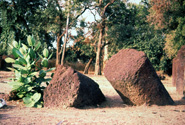
UNESCO (2006)
Consisting of four large groups of stone circles that represent an extraordinary concentration of over 1,000 monuments in a band 100 km wide along some 350 km of the River Gambia. The four groups, Sine Ngayène, Wanar, Wassu and Kerbatch cover 93 stone circles and numerous tumuli, burial mounds, some of which have been excavated to reveal material that suggest dates between 3rd century BC and 16th century AD. Together the stone circles of laterite pillars and their associated burial mounds present a vast sacred landscape created over more than 1,500 years. It reflects a prosperous, highly organized and lasting society. The stones were quarried with iron tools and skillfully shaped into almost identical cylindrical or polygonal seven-ton pillars, on average about two metres high. Each circle contains between 8 and 14 pillars and is 4 to 6 metres across. All are located near the burial mounds. This outstanding site is representative of a much wider megalithic zone in the region, which in terms of size, consistency, and complexity appears to be unrivalled anywhere in the world. The finely worked individual stones display precise and skillful working practices and contribute to the imposing order and grandeur of the overall complexes.

![BOIS-CAIMAN-1791-CLUB [the african memory]](https://blogger.googleusercontent.com/img/b/R29vZ2xl/AVvXsEjthfqy-hYzHw7sv58_RVCAameV_WrAgeWBzAhb5XeeFpM9EQegROHsrbJriUiTEbev2AudKEXMVqS4mZLgE3bgcQ6mNUNWzvXUhyphenhyphen-ugR-pL7ymfmq4WxS1dfBAtcPJFANmmtZZrVlYeFgx/s963/BannerBEST-aktuell----.gif)












































0 Kommentare:
Kommentar veröffentlichen